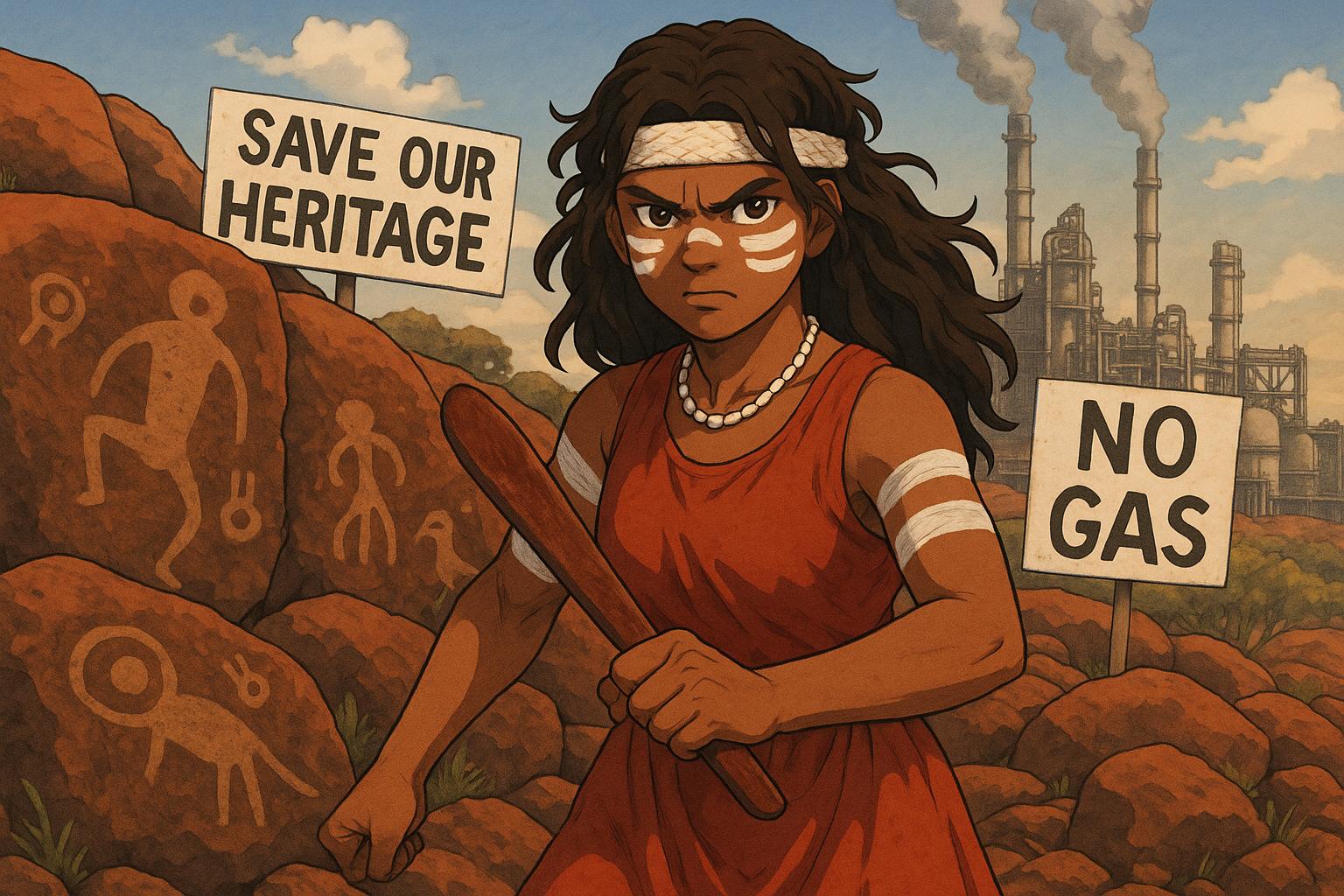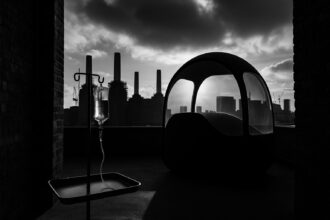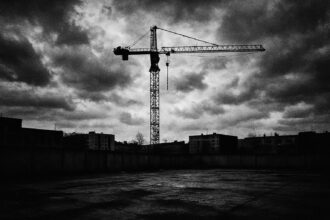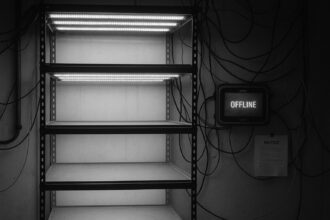A Mardathoonera woman and environmental advocates are taking legal action to force the Australian government to assess heritage protection for ancient rock art at Murujuga, as Woodside Energy’s North West Shelf LNG project gains approval to extend operations until 2070 amid fierce cultural and environmental concerns.
A significant legal challenge is unfolding in Australia as environmental activists push for the protection of Indigenous rock art located on the Burrup Peninsula, home to some of the oldest and largest collections of petroglyphs in the world. This development comes in the wake of the federal government’s interim approval for Woodside Energy’s North West Shelf gas project extension, allowing operations to continue until 2070.
The lawsuit, spearheaded by Raelene Cooper, a Mardathoonera woman and co-founder of Save Our Songlines, aims to compel the government to assess a heritage application that has been pending since early 2022. Cooper expressed her frustration outside the Federal Court in Sydney, stating, “I am furious that the minister would make a decision to lock in ongoing and irreversible damage to my country before addressing my application.” The court will hear Cooper’s case in the week of July 14, marking a critical juncture in the battle to safeguard Indigenous cultural heritage against industrial encroachments.
Minister for the Environment, Murray Watt, has indicated that rigorous conditions addressing air quality and cultural heritage will accompany the approval of the gas project. However, critics, including environmental groups and Indigenous advocates, argue that these measures are insufficient to mitigate the detrimental impact on the petroglyphs and the broader ecosystem. Woodside has just ten days to respond to these conditions, yet tensions continue to escalate as the project may exacerbate the already significant greenhouse gas emissions associated with the facility.
Woodside’s North West Shelf, Australia’s oldest and largest liquefied natural gas (LNG) plant, plays a vital role in supplying energy to Asian markets. The project extension, however, has sparked fears that it would release up to 4.3 billion metric tons of carbon emissions, an outcome condemned by climate advocacy groups like Australia’s Climate Council, which described the approval as a failure in climate leadership. These concerns are amplified by the recent nomination of the Murujuga Cultural Landscape for UNESCO World Heritage status, sparking hopes for greater international protection of this ancient site, despite the ongoing industrial threats.
Separately, a provocative protest related to Woodside’s industrial activities has resulted in three activists receiving hefty fines for what they labelled a “successful hoax.” The protestors, who disrupted a recent Woodside annual general meeting using stench gas and flares, claimed their actions were intended to highlight the environmental and cultural stakes involved, with one activist asserting that they might one day face charges for much more severe crimes against future generations.
The Burrup Peninsula, referred to as Murujuga by its traditional custodians, has long been a focal point of contention between development and preservation. Recent decisions regarding new industrial projects, such as a proposed $4.5 billion fertiliser plant by Perdaman Industries, have drawn ire from traditional custodians. While the company asserts it has support from local elders, some community leaders have contested these claims, arguing that misinformation has left many uninformed about the potential risks to sacred rock art.
As legal proceedings and public sentiments intertwine, the outcome could significantly influence the balance between economic development and cultural preservation. The government remains under pressure to ensure that Indigenous voices are adequately represented in decisions affecting their land, reflecting a broader discourse on how to proceed with industrialisation while respecting sacred heritage sites.
With the upcoming court case and ongoing environmental protests, the stakes have never been higher for the future of the Burrup Peninsula and the ancient stories etched into its rocks.
 Reference Map:
Reference Map:
- Paragraph 1 – [1], [2]
- Paragraph 2 – [1], [5]
- Paragraph 3 – [2], [3]
- Paragraph 4 – [2], [6]
- Paragraph 5 – [1], [4]
- Paragraph 6 – [1], [7]
- Paragraph 7 – [1], [5]
Source: Noah Wire Services
- https://www.dailymail.co.uk/news/article-14787735/Indigenous-advocates-energy-company-rock-art.html?ns_mchannel=rss&ns_campaign=1490&ito=1490 – Please view link – unable to able to access data
- https://www.reuters.com/business/energy/australia-approves-woodsides-north-west-shelf-lng-project-extension-2025-05-28/ – Australia has conditionally approved Woodside Energy’s request to extend the operation of the North West Shelf liquefied natural gas (LNG) plant until 2070. The plant, located on Western Australia’s Burrup Peninsula, is the country’s oldest and largest LNG facility and a critical supplier to Asian markets. The decision follows a six-year review delayed by environmental concerns, particularly over the plant’s emissions potentially damaging ancient Indigenous rock art in the Murujuga landscape, which Australia nominated for World Heritage status in 2023. Environment Minister Murray Watt emphasized that strict conditions related to air quality and cultural heritage would apply, and Woodside has 10 days to respond. The extension supports the continued operation of the LNG plant and may enable the development of new gas fields such as the dormant Browse project. However, the plan could result in up to 4.3 billion metric tons of carbon emissions, drawing criticism from environmental groups like Australia’s Climate Council, which labeled the move a failure in climate leadership. Despite the controversy, Woodside’s shares rose by 4% following the announcement, signaling investor support. The company has pledged to protect the Murujuga cultural landscape.
- https://www.abc.net.au/news/2023-02-10/burrup-rock-art-nominated-world-heritage-unesco-/101947896 – The federal government has formally nominated the Murujuga Cultural Landscape, encompassing the Burrup Peninsula in Western Australia, for UNESCO World Heritage listing. This nomination aims to strengthen the protection of ancient rock art, which holds significant cultural and spiritual value to Indigenous Australians. The Murujuga landscape is home to one of the world’s largest and oldest collections of petroglyphs, with evidence of continuous traditional culture over at least 50,000 years. Despite the nomination, concerns persist among traditional custodians and environmental groups about the impact of industrial developments in the area, particularly regarding emissions from facilities like Woodside’s North West Shelf gas plant, which could potentially damage the rock art.
- https://www.theguardian.com/australia-news/2022/mar/12/fertiliser-company-urged-to-halt-plans-to-remove-burrup-peninsula-indigenous-rock-art – Perdaman Industries plans to build a $4.5 billion fertiliser plant on Western Australia’s Burrup Peninsula, a region renowned for its extensive Indigenous rock art. The construction would necessitate the removal of rock art at three sites. While the company claims to have the support of traditional owners, this has been contested by some custodians who argue that elders were misinformed about the nature of the work. Concerns have been raised about the potential destruction of sacred sites and the cumulative effect of air pollution from increasing industrial development in the area, which could damage the rock art.
- https://www.abc.net.au/news/2024-08-28/aboriginal-elders-unhappy-burrup-peninsula-development/104275424 – Aboriginal elders with connections to Western Australia’s Burrup Peninsula have expressed dissatisfaction with the extent of industrial development near culturally significant sites. An agreement with the state government prevents the area’s approved traditional owner body, the Murujuga Aboriginal Corporation (MAC), from lodging objections to industrial developments on the peninsula. This ‘no objection’ clause has been a point of contention, with elders feeling excluded from decision-making processes regarding the land, which holds deep spiritual value and contains some of the world’s oldest rock engravings.
- https://www.thenewdaily.com.au/news/state/wa/2023/11/27/ancient-art-sites-unesco-nomination-fixed – The Burrup Peninsula, home to the world’s largest and oldest collection of petroglyphs, has had its World Heritage application remedied after the government’s initial nomination was deemed incomplete. The delay means consideration for the sacred rock art will not begin until 2025. Activist group Save Our Songlines has raised concerns about the impact of industrial activities, particularly gas drilling by Woodside, on the area. The government acknowledged issues with the initial submission, including map boundaries and topography, and has worked with Indigenous communities to update the application.
- https://www.theguardian.com/australia-news/2022/jun/07/tanya-plibersek-urged-to-protect-indigenous-rock-art-up-to-50000-year-old-by-blocking-45bn-wa-fertiliser-plant – Traditional custodians have urged Environment Minister Tanya Plibersek to protect ancient rock art, some up to 50,000 years old, by blocking the construction of a $4.5 billion fertiliser plant by Perdaman Industries on Western Australia’s Burrup Peninsula. The plant is expected to produce two million tonnes of fertiliser-grade urea annually and plans to use gas from Woodside’s nearby Scarborough project. Traditional owners fear that the development poses a serious risk of desecrating their land and that the plant should be moved from Burrup Peninsula to prevent damage to the petroglyphs.













